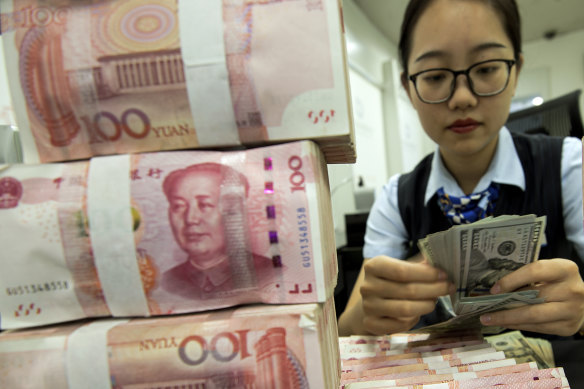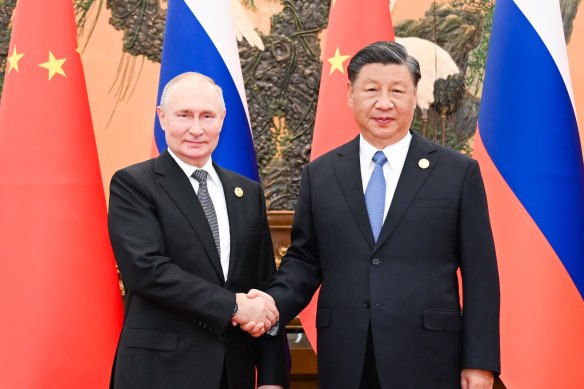
Why the rise of China’s currency can’t be ignored
Save articles for later
Add articles to your saved list and come back to them any time.
This year’s near-doubling of the yuan’s share as a global payments currency has largely gone unremarked because the figures are still rather modest, and forecasts of the dollar’s impending demise have so far turned out to be greatly exaggerated.
Besides, the world’s attention is fixated on China’s wobbly domestic growth. The yuan as a vehicle for the nation’s geopolitical ambitions is getting sidelined, much like the tapering enthusiasm for President Xi Jinping’s $US1 trillion ($1.5 trillion) Belt and Road project.
The yuan is becoming more of an international force.Credit: AP
Yet, ignoring the yuan’s rise might be a mistake. Going by the experience of treasurers at multinational firms, Beijing’s two-decade-old project to put its own legal tender in the race for preeminence — and the exorbitant privilege that comes with it — seems to have got some momentum.
As the Natixis SA economist Alicia Garcia Herrero wrote this week in the Financial Times, a “weak renminbi has achieved something quite impressive in 2023: a fast increase in its cross-border use.” With a 47 per cent share, the US currency is still miles ahead, though if the trend sustains, the increase in the yuan’s use in global payments to 3.6 per cent in October — from 1.9 per cent in January — could be the starting point of the most serious challenge yet to the greenback’s dominance in international commerce.
A number of things have changed. China’s 30-plus bilateral currency swap lines with other central banks that used to sit idle, are now, as Garcia Herrero notes, getting drawn in financially strapped countries like Argentina. That’s putting more yuan into circulation outside national borders. Chinese banks are increasingly lending overseas in their local currency, which works out cheaper for borrowers because of high US interest rates.
While Belt and Road is getting reprioritise toward more “small and beautiful” projects, “greater use of yuan in overseas investment by financial institutions” is now an explicit goal, according to a recently released government document laying out the next 10 years of Xi’s vision.
Russia’s war in Ukraine, and the subsequent Western sanctions, are providing the backdrop by making Moscow critically dependent on Beijing. Even state-owned refiners in India are being pressured by Russian oil suppliers to pay in the Chinese currency, a demand that doesn’t sit well with the government in New Delhi.
Alongside these relatively better-known drivers, a big push to internationalise the yuan is coming from corporate treasuries’ cash pooling.
Most of the world’s multinationals are now in China, with their operations spewing out cash on a daily basis. Ideally, the corporate treasurer would like to consolidate yuan balances scattered across the country into one cross-border sweeping account, freely lending into and borrowing from an offshore yuan facility the company maintains in, say, Hong Kong or Singapore. But thanks to the country’s cumbersome capital controls, sending cash out of China has always been problematic and unpredictable.
Those processes are becoming easier. The People’s Bank of China and the State Administration of Foreign Exchange ran a pilot program in March 2021, when they allowed some multinationals in Beijing and Shenzhen to integrate local and foreign-currency cash pools and transfer them between their domestic and overseas subsidiaries without prior approvals. Last July, the facility was expanded to many other regions.
Vladimir Putin with Xi Jinping. Russia is becoming more dependent on China. Credit: Getty Images
This year, Beijing and Guangdong were chosen for a fresh pilot that offers yet more flexibility, leading to lower hedging costs and better risk management. “Many of our major multinational clients have already taken advantage of these rule changes to integrate their China operations in offshore corporate treasury centres,” Societe Generale SA noted in October. Chinese interest rates are not attractive, but bankers expect a greater willingness among global firms to hold yuan balances as the difference with dollar deposit rates narrows.
Is this a gradual move toward a freer capital account? Ultimately, Beijing will have to move in that direction and let firms take money out of the country without having to wait for a banker to tell them if they can. Not only will this push for expanded use of yuan in trade, but may also help position the currency as a more viable choice for wealth owners.
Even with full convertibility, however, the dollar will continue to enjoy a significant advantage because of the unrivalled depth of the US capital market and the greenback’s vehicle-currency status: When moving money across borders in illiquid corridors, the dollar is simply the most efficient go-between. Although Beijing wants to counter this source of hegemony with a digital version of the yuan, a makeover of the $US7.5 trillion-a-day foreign-exchange market won’t occur overnight.
Above all, authorities will have to focus their energy on anemic domestic growth and a bloated property industry. Greater support for financially stressed regional and local governments may pose “broad downside risks to China’s fiscal, economic and institutional strength,” according to Moody’s Investors Service, which last week cut its outlook on the country’s A1 sovereign rating to negative from stable.
It will be unreasonable, therefore, to expect a sudden lurch toward greater convertibility, or a swift increase in the yuan’s share of global payments. Yet, slow as it may be, progress seems more assured than when internationalisation first began in 2004.
Bloomberg
The Market Recap newsletter is a wrap of the day’s trading. Get it each weekday afternoon.
Most Viewed in Business
From our partners
Source: Read Full Article

